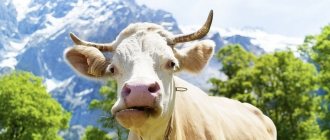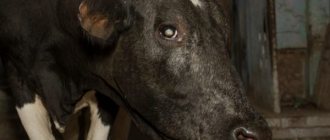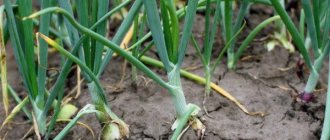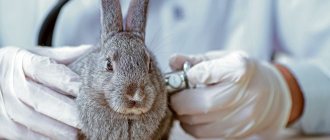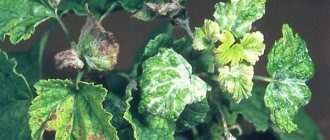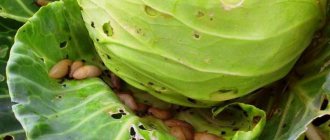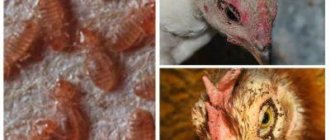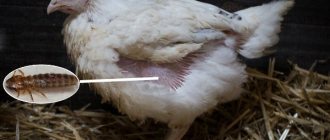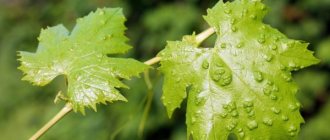Preventive measures
Prevention of cattle consists of general deworming twice a year with the introduction of antiparasitic injections.
In summer, to control flies in barns, measures are taken to reduce the number of disease vectors and flies. Insecticidal solutions are used for treating sheds, and traps are installed to catch larvae and insects.
Particular attention is paid to the prevention of helminthiasis in the barn, since frequent damage to the conjunctiva in cattle (telasiosis) can cause complications and loss of vision
Note! It is important to vaccinate animals and conduct regular scheduled eye examinations in order to promptly detect clouding of the lens in cows. You also need to keep the barns warm and clean.
It is dirt, cold and dampness that are the provoking factors leading to diseases in domestic cattle.
It is dirt, cold and dampness that are the provoking factors leading to diseases in domestic cattle.
You also need to keep the barns warm and clean. It is dirt, cold and dampness that are the provoking factors leading to diseases in domestic cattle.
Note! It is important to vaccinate animals and conduct regular scheduled eye examinations in order to promptly detect clouding of the lens in cows. You also need to keep the barns warm and clean. It is dirt, cold and dampness that are the provoking factors leading to diseases in domestic cattle.
It is dirt, cold and dampness that are the provoking factors leading to diseases in domestic cattle.
It is dirt, cold and dampness that are the provoking factors leading to diseases in domestic cattle.
What can cause the disease
The main preventive measures are timely deworming and destruction of flies living in the pasture. Deworming is carried out twice a year: when placing them in stalls for the winter and before the first spring pasture on the field. Flies are eliminated with the help of Ectomin, Neostomazan, Neotsidol.
The first treatment is carried out before the cattle are taken out to pasture, and then once a week or as necessary. Neocidol emulsion is used to treat stalls and other premises. About 100 ml of product is required per 1 m2.
The procedure should be carried out only in an empty room. Animals are first taken out to pasture. You can start them back after at least 2 hours. In agricultural enterprises, it is advisable to use special disinfection machines. They create the necessary pressure, so insecticides are sprayed more effectively.
If you liked the article, please like it.
Tell us about your experience in treating thelaziosis in cows.
Tags:Diseases, Cows
Breeding and general rules for caring for cattle at home
Providing proper care, maintenance, and breeding is the key to obtaining excellent meat and tasty, healthy milk in the end. The main measures include arranging an insulated barn for the cow during the cold season, providing a sufficient amount of light, and creating an exhaust hood to supply fresh air.
Besides:
it is better to lay wooden floors in barns with a slight slope so that urine drains and the cows do not suffer from cold, mastitis, or inflammatory diseases; It is important to keep barns clean, removing manure 1-2 times a day, equip stalls with feeders with a sufficient amount of root vegetables, oats, and bran placed in them; in the summer season it is better to keep the cows under a canopy, installing feeders in the open air; introduce pasture (vegetables, fruits), hay, silage, wheat bran, crushed grain, barley straw into the diet of cows; A sufficient supply of heat and fresh water must be provided to prevent dehydration. The cow's eyes are watering
The cow's eyes are watering
Cows are often kept by farmers for the purpose of breeding and producing young calves. This is a profitable business that has long been familiar to specialists from history. A pregnant cow walks for up to 9 months, so in the later stages the farmer must monitor the process of delivery to avoid complications in cows. It happens that the calf simply has to be pulled out, immediately separated from the mother, so that infection does not occur.
Important! For intensive milk production and annual births, it is important to keep the health of the cows under close control, including providing sufficient water, especially after calving. Water should always be in abundance. Diseases also need to be detected on time and treatment started
Diseases also need to be detected on time and treatment started.
Eye pathologies are a common occurrence. Farmers periodically carry out preventive work in the barn, remove uneaten food, and eliminate inconveniences such as sharp, piercing objects.
Tips and tricks from experienced livestock breeders and veterinarians
Experts advise new farmers to first carry out annual parasite control or deworming, especially for calves of the current year of birth, keeping them indoors. Besides:
On hot summer days, it is important to prevent cows from injuring their eyes. Choose safe pastures for walking. There should be no dangerous places in barns where cows could injure their eyes. Vaccinate animals against infectious diseases in a timely manner, especially during the period of estrus in heifers, and treat the premises against flies with insecticides. For the purpose of prevention, you can give calves tetramizole, albendazole against parasites, adding them to the feed, drinking bowls, or in diluted form. Tetramisole
The most common reason why the eyes of cows become watery and fester is a cataract.
It causes inconvenience, so it is important to examine the cows daily and timely isolate the sick from the rest of the herd. The cause of purulent thelaziosis can be feeding. It is important to dispose of uneaten food in a timely manner. A cow's eyes are seriously damaged by ultraviolet radiation, chemical exposure, and lack of adequate nutrition. Experts recommend using repellents that repel flies. They need to be sprayed daily on the skin of animals, as well as lubricate the eyes with non-irritating ointments. Ichthyol, Lysol based on fish oil, can help with eyesores when redness, watery eyes, and inflammation of the conjunctiva appear. You can douche the conjunctivitis sac by massaging the orbital area.
If a cow’s eyes are festered and watery, then this is a clear sign of a foreign object entering and the development of inflammation.
It is important to start treatment on time. Eye diseases can be costly for animals, including death
Some infections are contagious and can therefore be transmitted from cow to cow when visiting the herd. All this can be avoided by providing care for the cow.
Article Rating
Parasites can also cause illness
The nematode Thelasia rhodesi (Thelasia) commonly infects cattle during the summer. Thelaziosis becomes the main cause of lacrimation in cows during this period. The intermediate hosts of thelyas are flies.
Infection leads to conjunctivitis and keratitis. The cow's eyes become red and watery. In addition to lacrimation, photophobia and corneal clouding, this helminthic disease is manifested by serous-purulent discharge from the eyes, which sticks the eyelashes together. Without treatment, the inflamed cornea becomes covered with ulcers and scars appear on it.
Damage to the lens is also possible. A sick cow may go blind. She eats poorly, loses weight, and her milk production drops. Treatment of thelaziosis is carried out in two stages: drug ridding of the animal from parasites using conventional means of combating worms and restoration of damaged mucous membranes of the eyes.
How to treat eyesore?
In order not to harm the animal, if you find a cataract or something similar to a cow’s eye, you need to show it to a veterinarian. Only a qualified specialist will prescribe effective treatment. Before the veterinarian arrives, many experienced farmers recommend treating a cow’s eyesore using folk remedies. The most effective way to treat a cataract is with powdered sugar. To do this, you need to take regular sugar and mash it until it becomes powdered sugar.
You can do this in a coffee grinder or other devices
It is very important to grind the sugar to a weightless powder; if even one part of the sugar remains coarse, it can scratch the animal’s eyelid. The resulting powdered sugar must be blown onto the thorn.
If you can’t blow it off onto the spot, you can put the powder behind the lower eyelid.
The procedure with powdered sugar is carried out several times a day, depending on the development of the disease. Most often, 3-5 days are enough for healing, so you need to repeat the process every day for 4 days.
Handy tools for restoring vision
As a result of inflammatory processes and damage to the cornea, a cataract (leukoma) can form. Scar tissue makes the thin cornea of the eye opaque - the eyes become cloudy and a white spot appears on them. It happens that a calf is born with an eyesore. This means that he suffered inflammation during fetal development.
To make animals see again, you can blow powdered sugar (powdered sugar) under the lower eyelid 3-4 times a day. It is important that there are no hard lumps left in the powder. Experienced owners claim that this way you can remove an eyesore in a week. However, with deep inflammation and hyperemia, such therapy will not give results soon. Treatment may take a month or more. Medications will lead to recovery more effectively.
How to treat a cow's eyesore
If an eyesore is detected on a cow, it is not recommended to independently treat the animal. Medications should be prescribed by a veterinarian, and traditional methods of treatment should in no case replace them entirely. They can only act as auxiliary means.
Important! Treating eyesores in cattle is a long and quite difficult process. Full recovery occurs on average after 1-1.5 months
Drug treatment of eyesore in cattle
Drug treatment may include the use of the following medications:
- 1% solution of "Chlorophos". Rinsing the affected eye is carried out according to a doctor’s prescription, the recommended frequency of procedures is 3-4 times a day. If inflammation is severe, this amount is increased to six times a day. Sometimes, instead of rinsing, the veterinarian may prescribe injections behind the third eyelid.
- Tetracycline ointment. It is applied to the eyelids as an independent treatment 2-3 times a day or lubricated at the injection site after using the Chlorophos solution.
- "Albendazole". The veterinarian prescribes this remedy if the eyesore appears as a result of helminth infection. It is applied once at the rate of 1 ml per 10 kg of cow weight.
- Iodine solution. This remedy is used against thelaziosis, which causes the appearance of an eyesore. 1 g of crystalline iodine must be mixed with 2 g of potassium iodide and diluted in a glass of boiling water. When the solution has cooled, it is drawn into a special syringe or syringe and the eye is treated, while the stream should be directed to the inner corner.
- 0.5% carbolic acid. To wash the cataract, a small amount of carbolic acid is diluted in 200 ml of water. The exact dosage and frequency of washings is prescribed by the veterinarian.
- 3% boric acid solution. This remedy is also used against helminths. The solution is drawn into a syringe and washed out the sore eye of the cow.
Treatment should be systematic and constant; skipping even one procedure is undesirable
It is important to follow all the doctor’s instructions exactly, otherwise the treatment of the cataract will last for many months.
Folk remedies for cow eyesores
Powdered sugar is very popular against eyesores, which is explained by the effectiveness and low price of this folk remedy. It’s very simple to make – just pour granulated sugar into a coffee grinder and grind it to a powder. This will take some time, because large particles of sugar can only make the situation worse.
You can use powdered sugar in two different ways. The first is to gently blow the powder onto the eyesore. The second involves diluting powdered sugar in water, but there is no need to completely dissolve it - the result should be a viscous mass, which is applied to the sore eye like an ointment. Some farmers prefer to place it under the cow's lower eyelid.
It is necessary to treat a cow's eyesore 4-5 times a day. Powdered sugar effectively copes with the symptoms of the initial stage of the disease - the thorn becomes smaller in size and fades already on the fifth day, however, the powder cannot completely cure the inflammation. This requires full-fledged drug treatment, and sometimes surgical removal of the cataract may be required.
Advice! Lotions made from dandelion infusions have proven themselves to be effective in treating eyesores.
A cow's eyes are festering: what to do?
Bloody discharge from a cow after covering
At the initial stage, conjunctivitis in cows and calves does not cause problems and quickly goes away in 1-2 weeks if you promptly rinse the eyes with potassium permanganate, rivanol, boric acid (3% solution), and clear the mucous membrane of bacteria and foreign liquid.
Many beginners do not know how to treat if a cow’s eyes fester. For purulent conjunctivitis, treatment should be comprehensive:
- furatsilin (solution) with washing of the conjunctival sac;
- eye ointments applied 2-3 times;
- painkillers (novocaine, dimexide, calcium chloride);
- antibiotics for follicular conjunctivitis;
- eye ointments for the treatment of the parenchymal form of the disease.
Conjunctivitis in cows caused by infection is more difficult to treat. If a cow has difficulty opening her closed eyes, then novocaine blockades are placed and antibiotic injections are prescribed. In addition, local ointments for lacrimation are placed in the conjunctival sac.
Conjunctival sac
Sometimes, to open a cow’s eyes when there is accumulation of pus, surgery is needed - the surest method to avoid blindness.
When the symptoms of thelaziosis are clearly expressed, the following are used for treatment:
- boric acid solution, potassium iodide for washing the animal's eyes from a syringe;
- antibiotics (sulfonamides, penicillins) for complications and severe damage to the cornea by infection.
Keratitis in cows with redness and tearfulness of the eyes is treated with a solution of boric acid, sulfonamides for washing the conjunctival sac, and orbital blockades are placed. To support the cow’s well-being, vitamin complexes (trivitamin, retinol) are prescribed.
For eyesores caused by helminths, veterinarians prescribe antiparasitic drugs: chlorophos (1%), dandelion infusion lotions, tetracycline ointment. Folk remedies help quite well, for example, placing powdered sugar under the eyelid and fixing the head of a sick animal to one side.
For your information! The danger is purulent panophthalmitis (rotting eyes). Then specialists resort to surgery to remove the eye. No less terrible is a banal allergy, which can cause severe lacrimation, clouding of the transparent membrane, up to the onset of partial loss of vision.
The structure of the visual organ in cattle
To find out whether cows and bulls differ in color or not, it is necessary to consider the structure of the animals' eyes. The cow's eye is an eyeball in which the visual receptors are concentrated. They are connected to the brain by a conductor and a nerve. A bull's eye is larger than a cow's. The eyeball is located in the orbit, which is formed by the bones of the skull. It consists of an outer, middle, inner shell, light-refracting media, nerve endings, and blood vessels.
The outer shell consists of the cornea and sclera, which is also called the tunica albuginea. The sclera has thick walls consisting of fibrous tissue. This is the skeleton of the eyeball. Muscular tendons are attached to the sclera, which hold the eye and carry out its work. The cornea is a transparent layer. It has no blood vessels, but has many nerve endings, so it is sensitive to pain and pressure. The cornea conducts light to the retina.
The tunica media consists of the iris, ciliary body and choroid.
- The iris has pigment. In the center is the pupil, which is capable of contracting and expanding, regulating the flow of light.
- The choroid is located between the retina and sclera. It is connected to blood vessels that supply nutrition to the eyeball.
- Between it and the iris is the ciliary body. This is the muscle that holds the crystal, making it more or less convex.
The inner layer is the retina. Its back part is visual. This is where light reflection is perceived and converted into a nerve signal. The nerve layer contains rods, receptors that provide daytime vision, and cones. They are responsible for color perception. The location of the cones can determine how well an animal distinguishes color. Experts say that a cow can see red, green, blue, black and white, but the perception is not very clear and dim.
The cavity of the eyeball contains the lens. This is a biconvex lens that can change its surface. Thanks to it, the animal sees well both distant objects and those in front of it. With age, the lens becomes less elastic, and the ability of accommodation decreases.
Between the lens and the retina is the vitreous body. It consists of 98% water. The vitreous body maintains the shape of the eye, participates in metabolic processes, and contributes to its tone. It promotes the conduction of light.
The visual apparatus consists not only of the eyeball, but also of additional organs that ensure good functioning of the eye.
Structure of the eye in cattle
- The eyelids protect the eyes from mechanical damage. There are two of them: upper and lower. On the inside they are covered with mucous membrane and conjunctiva.
- The nictitating membrane is located in the inner corner.
- The lacrimal apparatus moisturizes and removes foreign particles from the cow's eye. It secretes tear fluid, which consists of water and lysozyme. Lysozyme is an enzyme that has an antibacterial effect.
The structure of a bull's eye is no different from that of a cow. Experts note that cattle have good night vision. This is provided by refractive media. Light that is reflected from an object can be amplified. In the dark, animals' eyes glow. This ability is somewhat lost during the daytime.
Are cows colorblind?
The location of the photoreceptors in the cow's eyes suggests that it distinguishes primary colors, although not as clearly as we do. There is no talk of any difference in shades at all. Color blindness can be inherited, or (much less commonly) developed in an animal whose ancestors could normally distinguish colors.
It should be said that some special reaction to the color red (the famous bullfight) in bulls is nothing more than a legend; cattle react to red and its shades in the same way as to other colors.
It is not the color that irritates the animal, but the mechanical movement of the obstacle in front of it (the bullfighter shakes his cloak, the animal perceives the cloak not as a piece of fabric, but as a barrier, an obstacle, which, moreover, shakes).
And the red color of the cloak is due only to the drama of the show. Firstly, this color is clearly visible from afar, and secondly, the combination of red and black (bull color) is generally a classic, and, of course, there is some symbolism, because red, first of all, is the color of blood.
Conjunctivitis (inflammation of the conjunctiva)
The conjunctiva is a thin transparent film that covers the surface of the eye and part of the eyelid. When exposed to various factors, it can become inflamed. The process of inflammation in veterinary medicine is called conjunctivitis.
Reasons for development
In cattle, conjunctivitis can develop due to the following reasons:
- Mechanical damage. This category includes strong blows to the eye area, damage to the conjunctiva by foreign objects caught under the eyelid. Inflammation can also form as a result of the eyelid turning inward and scratching the surface of the eye with eyelashes.
- Other infectious diseases. With a general inflammatory process caused by the disease, eye inflammation manifests itself as one of the symptoms.
- Chemical exposure. The inflammatory process can also be caused by various chemicals that get under the eyelid. These include ammonia, dust and lime fumes, lye, various acids, and individual components of chemical fertilizers.
- Dysfunction of the lacrimal gland. When the conjunctiva dries out excessively, cracks appear on it, in which pathogenic microflora develop.
- Allergy. In case of allergic reactions of the body, the amount of protein in tears increases. As a result, an optimal environment for bacterial activity develops on the surface of the eye.
Bacteria that cause inflammatory processes can also be introduced into the body by flies and ticks that land on the eyes.
Symptoms
Clinical signs are pronounced. The incubation period ranges from 3 to 10 days. After its completion, the disease can manifest itself in several forms:
- catarrhal;
- phlegmonous;
- purulent;
- follicular.
Conjunctivitis in cattle
The onset of the disease is indicated by the following symptoms:
- a slight increase in the cow's body temperature;
- redness of the conjunctiva;
- swelling of the eyelids;
- developing photophobia, due to which the animal constantly keeps its eyes half-closed;
- superficial or deep inflammatory injection of blood vessels.
If conjunctivitis in cattle has become chronic, redness of the membrane may be absent. Instead, it takes on a bluish color.
Some symptoms appear only in specific forms of the disease. So, with purulent inflammation, gray, white or green exudate flows from the conjunctival sac, which dries on the skin under the eyes. The catarrhal form involves strong tear production. With follicular conjunctivitis, inflamed follicles appear in the third eyelid, and with phlegmonous conjunctiva, the conjunctiva swells greatly.
Important! If the disease in livestock was caused by an allergy, the outer transparent membrane may become cloudy, which subsequently leads to partial or complete loss of vision
Treatment
Before starting treatment for the disease, its form is clearly determined. For any of the manifestations, first wash the conjunctival sac. A solution of boric acid is used for washing. You can also use furatsilin. Before use, the solutions are slightly warmed up.
To treat a purulent form of inflammation of the conjunctiva, antibiotics are injected into the conjunctival sac, as well as sulfacyl in the form of a 30% solution. For catarrhal conjunctivitis, eye drops of zinc sulfate are also added to the already indicated procedures twice a day. If necessary, it is possible to replace the drug with a resorcinol solution with the same concentration.
In the case of follicular inflammation of the conjunctiva, the follicles are first treated with lapis, retracting the eyelid. After cauterization, lapis is washed with sodium chloride (4.5% of the substance in solution with water).
Tetracycline-based ointment
A special ointment based on novocaine and tetracycline also effectively copes with conjunctivitis.
Keratitis (inflammation of the cornea)
Keratitis in cattle develops when the cornea of the eyeball is damaged. The main reasons for the development of the disease are:
- Mechanical damage, which includes blows and punctures from sharp objects.
- Thermal burns.
- Exposure to chemicals.
- Infectious diseases in which keratitis is one of the symptoms.
Keratitis can be deep or superficial. The first one can be easily treated at home. The second form requires surgical intervention by a veterinarian.
Causes
The occurrence of inflammation in the eyes of cattle is influenced by many reasons. The fact is that the conjunctiva constantly interacts with the external environment, air, and microbes are invariably present in the bag.
Infectious keratoconjunctivitis
The sensitive membrane is affected by all processes accompanying diseases of internal organs, metabolic disorders and infections:
- mechanical factors. Injury to the conjunctiva from foreign objects, injury to the eyelids and their failure to close, contact with eyelashes and other factors cause mechanical damage and contribute to the onset of the disease;
- chemical factors. Negligence in cleaning pens from manure, lack of ventilation, and the spread of ammonia cause irritation of the conjunctiva. Smoke, medicinal aerosols, disinfectants and others have a similar effect;
- physical factors. The cow does not like sudden changes in temperature, especially too much heat, unusually a lot of sun after the end of winter;
- biological factors. Fungi appear in the eyes with bad rotting food, with bacteria and microflora that are in the conjunctival sac;
- infections. A companion of chlamydia, smallpox, catarrhal fever, thelaziosis and other diseases is conjunctivitis.
Why do cows' eyes water and fester?
Horses eyes
Cows' eyes water and fester most often due to conjunctivitis - the development of an inflammatory process due to the accumulation of microbes in the lacrimal sac. Various provoking factors:
- sudden changes in temperature;
- insufficient feeding;
Insufficient feeding
- weak immunity;
- infection of cow eyes;
- injury to the mucous membrane of the eyes by foreign objects;
- contact with the mucous membrane of chemical agents (disinfecting aerosols, smoke, ammonia), causing irritation and conjunctiva;
- accumulation of bacterial particles and rotten food in the conjunctival sac;
- allergies caused by a high amount of protein in tears, the development of bacteria on the surface of the orbit;
- disruption of the lacrimal gland;
- development of pathogenic microflora due to excessive drying of the conjunctiva of the eye.
Common eye diseases in calves and cows:
- Thelaziosis is an infectious disease, most often diagnosed in cows in the summer, caused by small nematodes. The result is photophobia, lacrimation, swelling and inflammation of the conjunctiva, clouding of the cornea, suppuration, and gluing of eyelashes with purulent serous fluid.
- Keratitis is an inflammation of the cornea of the eye, causing lacrimation, clouding of the lens, and a painful reaction to light in cattle.
- An eyesore is scarring of inflamed tissue due to mechanical stress on the cornea of the eye.
Often the eyes of cattle become inflamed, watery, and fester due to the development of the inflammatory process against the background of the introduction of bacteria together with ticks and flies. In summer, parasites constantly attack the eyes of cows.
Note! Only an experienced veterinarian can identify the real cause of inflammation after a thorough examination. For uncomplicated conjunctivitis, therapy is nonspecific: novocaine blockades, vitamin complexes. If there is purulent flow from the eyes, surgery may be necessary, otherwise the cow may lose her sight.
Massive keratoconjunctivitis
Keratoconjunctivitis combines inflammation of both the conjunctiva and the cornea. This disease can become widespread during certain periods of the year. It manifests itself most acutely in young cattle.
Causes
There are several reasons for the development of such an inflammatory process in the body. The main ones include:
- Infection with helminths that parasitize the eyes of livestock. Such parasites enter the body while calves are grazing on pastures.
- Spring hypovitaminosis A. In the spring, due to increased activity of cows, vitamin reserves in their tissues quickly decrease. And if reserves are not replenished in a timely manner, keratoconjunctivitis and a number of other diseases develop.
- Rickettsia infection. This type of bacteria is capable of parasitizing the eye tissues of young cattle, causing inflammatory processes in them. In this case, the disease becomes infectious.
Symptoms
Clinical signs directly depend on the form of the disease. If inflammation is caused by hypovitaminosis, then it is characterized by the following manifestations:
- decreased corneal transparency;
- hardening of the upper layers of the protective film and their rejection;
- increased sensitivity of the eye;
- In severe forms of the disease, a hole may form in the cornea, resulting in loss of vision.
Sore eye in cattle
This form of the inflammatory process is also dangerous because the eyeball becomes overly susceptible to secondary infection. Against this background, damage to the ciliary body and iris may occur. In cases of complications, atrophy of the visual organs, abscesses, and glaucoma often develop.
If keratoconjunctivitis is caused by the activity of rickettsiae, the symptoms of the disease are as follows:
- excessive tearing;
- excessive photosensitivity;
- inflammation of the conjunctiva, accompanied by swelling and redness;
- discharge of purulent exudate;
- necrosis and separation of the upper ball of corneal cells;
- clouding of the pupil.
Attention! When the disease becomes more complicated, ulcers may appear on the cornea
Treatment
Sick cattle are provided with rest in rooms with poor lighting, their diet is normalized, and vitamin complexes are included in it. The affected eye is treated with syntomycin ointment (or similar) twice a day. For better effect, novocaine is added to it (no more than 3%).
If the disease is helminthic in nature, then, first of all, they get rid of the parasites. To do this, the conjunctival sac is washed with warm iodine solution. The procedure is carried out three times a day. Next, prednisolone ointment is injected under the eyelid, with the addition of novocaine and streptocide.
Important! If purulent panophthalmitis develops against the background of the disease, a specialist performs surgery to remove the eye. The key to a favorable outcome in the treatment of eye diseases in cattle is timely seeking help from a specialist. Therefore, it is necessary to conduct regular examinations of animals and call a veterinarian at the first suspicion of illness.
If you delay in solving the problem, the infection can quickly spread to most of the livestock, which will significantly increase the owner’s losses.
Therefore, it is necessary to conduct regular examinations of animals and call a veterinarian at the first suspicion of illness. If you delay in solving the problem, the infection can quickly spread to most of the livestock, which will significantly increase the owner’s losses.
The key to a favorable outcome in the treatment of eye diseases in cattle is timely seeking help from a specialist. Therefore, it is necessary to conduct regular examinations of animals and call a veterinarian at the first suspicion of illness. If there is a delay in solving the problem, the infection can quickly spread to most of the livestock, which will significantly increase the owner’s losses.
https://vetvo.ru/konyunktivit-krupnogo-rogatogo-skota.htmlhttps://7ogorod.ru/krupnyj-rogatyj-skot/u-korovy-glaza-slezatsa.htmlhttps://fermhelp.ru/bolezni-glaz- u-krs/
Symptoms of the disease
An attentive owner will immediately identify a disease in a cow. Since her field of vision becomes smaller, the cow sees poorly, she begins to move unnaturally: she walks sideways, constantly turning her head towards the healthy eye. The pathology in the eyes is determined by the gait.
Helminths secrete substances that lead to inflammation in the lacrimal glands and nasopharynx. The cow secretes copious amounts of mucous from the nose and tear fluid from the eye. In acute inflammation, blood clots are found in the mucus. The eye is swollen. The cow constantly shakes her head.
The cow behaves unnaturally, she experiences pain, discomfort, and exhibits photophobia. The animal moos, becomes restless and aggressive. The milking process is long. The cow does not give milk well. If necessary, she is tied or restrained. If a cow is not milked, mastitis may develop in the udder, which is accompanied by severe pain.
- signs of conjunctivitis;
- photophobia;
- lacrimation.
Thelaziosis of cattle is a type of helminthiasis. This disease is caused by nematodes belonging to the genus Thelazia.
Helminths penetrate into the conjunctival sac and under the third eyelid of the animal and cause various eye pathologies - from conjunctivitis to damage to the cornea.
In summer, an infected animal becomes a carrier of helminthiasis, at which time the incidence increases. According to statistics, in some large farms almost the entire livestock may be infected.
Thelaziosis
Thelaziosis is caused by a pathogen called thelaziosis nematodes. Their life cycle is a complex pattern. Let's look at it to get an idea about these helminths. Cow flies are directly related to the infection of animals. They are carriers of telezia.
When their flight begins, they attack cattle in pastures and land on the skin of animals near the palpebral fissure. Infective nematode larvae reach the eyelids and periocular area of livestock through the insect's proboscis. The further development cycle of nematodes takes place in the eyes of the affected animal.
In a suitable environment, the larvae grow and after some time become capable of reproduction.
Thelasia female is capable of producing live larvae that are not invasive. For them to become like this, cow flies need to participate in the process. They land on the eyes of livestock and swallow the first stage larvae.
In the body of the fly (in its follicles) they are modified twice and turn into invasive larvae. Then the process proceeds in a known way - flies infect healthy animals with thelyasia.
The disease spreads quickly with the onset of warm weather, and reaches its peak towards the end of summer.
Symptoms
There are three stages of thelaziosis. Each of them has its own symptoms of the disease. Let's look at them.
The initial stage of thelaziosis development in cattle can be recognized by the following symptoms:
- Tearing.
- Fear of light.
- Inflammation of the conjunctiva of the eyes.
At the second stage, thelaziosis manifests itself more acutely, the symptoms of the disease now look like this:
- The conjunctiva becomes swollen.
- Mucus and pus are released from the lacrimal canal and from under the eyelid.
The third stage of the disease is characterized by damage to the cornea of the eye. It becomes cloudy, ulcerated, and sometimes even bulges and perforates. The animal's temperature rises.
Reference. Ignoring the first two stages of thelaziosis often leads to irreversible processes in the eye - loss of vision is possible.
Diagnostics
The diagnosis of thelaziosis can be made by a veterinarian based on the studied clinical manifestations of the disease. If the symptoms are mild, which is typical for the first stage of helminthiasis, laboratory testing of tear fluid or conjunctival swabs may be required. The detection of sexually mature individuals of thelyasia and their larvae in the eye is the basis for making a diagnosis.
Developmental biology of Teliasia
Treatment
Treatment of thelaziosis is aimed at eliminating the causative agent of the disease, as well as eliminating complications. To combat Teliasia, eye washes are used. The following solutions are used for this:
- Potassium iodide.
- Boric acid.
To prepare an iodide solution, take a small amount of clean boiled water (100 ml). 1 gram of crystalline iodine is diluted in it, and 1.5 grams of potassium iodide is added to the resulting liquid. The resulting concentrate is diluted with water so that the total volume of the solution is 2 liters. Using this product, use a regular syringe to wash the animal’s eyes several times.
A solution of boric acid is prepared as follows: add 3 ml of concentrate per 100 ml. The corners of the eyes, eyelids and conjunctiva are washed with this product from a syringe or with a sterile bandage or cotton swab. Usually, three procedures with an interval of 4 days are sufficient to remove thelasia larvae.
Antibiotics
Antibacterial therapy is carried out in case of development of complications - purulent conjunctivitis and corneal infection. Penicillin antibiotics or sulfonamides are used for treatment. Preparations with mercuric chlorides are contraindicated for thelaziosis.
Purulent conjunctivitis
Drops, ointments
Treatment of conjunctivitis that has developed against the background of helminth infection is often carried out locally. In this case, use tetracycline ointment with the addition of novocaine or eye drops containing zinc sulfate and boric acid. If the veterinarian has detected clouding of the animal's cornea, it is recommended to treat the eye with an ointment containing potassium iodide.
Attention! Methods of preparation, dosage of the drug components and the regimen of use should be clarified with a veterinarian.
Antiparasitic agents
The treatment regimen for nematodes includes the use of anthelmintic and antiparasitic drugs. They are administered subcutaneously:
- Fascoverm.
- Pharmacin.
- Fenbendazole.
- Tetramizole.
- Albendazole.
- Riverteen.
Antiparasitic injections are also used to prevent the development of helminthiases. The treatment regimen and dosage are prescribed by the veterinarian.
Reference. After injections, drinking milk from cows or goats is allowed no earlier than 2 weeks. The animal is sent for slaughter 28-30 days after the use of antiparasitic agents.
Prevention
Preventive measures include general deworming of cattle in the fall and spring. Antiparasitic injections are used for this. If there is a need, helminthiasis prevention is also carried out in the summer.
Antiparasitic injections
Cowfly control is another measure to prevent an increase in the incidence of thelaziosis. In extreme heat, when the flight of insects increases, it is recommended to keep livestock in shaded, closed areas.
Farmers are also making efforts to reduce the number of flies that transmit the disease. To do this, young animals are periodically fed a phenothiazine-salt mixture. Animal feces become a trap for insect larvae - they die.
Before spraying, all animals must leave the premises, and after the procedure they are allowed to enter there after 2-3 hours. Insecticides are also used to treat animals (in large farms).
Thelaziosis is a common disease caused by helminths. It poses a danger to the animal, as it leads to many complications, including loss of vision in livestock. In very rare cases, a person can also be infected with this disease. That is why it is important to carry out timely prevention of helminthiasis and be attentive to your animals.
Symptoms
The main symptom of conjunctivitis is redness of the part of the eyeball located under the eyelids. The inner surface of the eyelids also turns red due to dilation of the membrane vessels. Sometimes the cornea is affected, which results in a lilac color. In addition, the specialist will notice puffiness, swelling of the conjunctiva, and loss of transparency.
There are additional pronounced symptoms:
- opening the diseased eye is difficult for the animal;
- leakage of fluid from the affected area;
- looking at the light is painful and unpleasant;
- the inflamed area itches;
- involuntary contraction of the muscles of the muzzle.
Next, we should highlight the indications characteristic of each form of this eye disease. They differ both in symptoms and in methods of treating conjunctivitis in cows:
- acute catarrhal conjunctivitis is characterized by the fact that the upper tissue is affected. The cow begins to fear light, tears flow, and her eyelids are swollen. The viscous liquid sticks the eyelashes together, body temperature rises slightly;
- chronic catarrhal conjunctivitis is not so clearly expressed. The membrane appears dry, the discharge is light, and is very rarely accompanied by pus. The animal may experience minor pain when the eyes are examined. When treatment does not occur for a long time, muscle cramps around the affected area may occur. Rarely does curling of eyelashes and eyelid margins occur;
- purulent conjunctivitis. In a healthy animal, the microbes that are always present in the eyes lie dormant. Natural lacrimation prevents them from becoming active. As soon as an infection settles in the body, a deficiency of vitamin A occurs, the microflora begins to change. The area around the inflamed eye becomes hot, and intolerance to light appears. Swelling of the eyes follows, the integrity of the mucous membrane is disrupted by ulcers. First there is white liquid pus, then it becomes thicker. The transition to the cornea and outer surface of the eyelids occurs quite quickly;
- Follicular conjunctivitis affects both eyes. It is often diagnosed with foot and mouth disease. Liquid accumulates in the inner corner. Often with this shape, the eye gap becomes smaller, the edges of the eyelids at the outer corner are slightly curled. Burgundy follicles form inside the third eyelid;
- parenchymal conjunctivitis is considered a more complex process. In this case, the conjunctiva and its internal tissue suffer. Both eyelids and the mucous membrane are inflamed, enlarged, the conjunctiva protrudes, looks tense, not moist, and blood appears. Sometimes tissue necrosis occurs;
- infectious keratoconjunctivitis affects young animals especially from three months to two years. It is often found in three-day-old calves. The infection is transmitted by flies and infected animals. They experience depression, fever, and poor appetite. Both eyes are most often affected. At first, the animal is afraid of light, it exhibits muscle spasms around the eyes, and fluid leaks from them. After this, the cornea swells and becomes cloudy, becomes covered with ulcers, and its integrity is compromised. Ultimately, blindness is likely.
How to recognize symptoms
The appearance of a cataract immediately provokes a decrease in visual acuity, so the owner can easily determine that something wrong is happening. The animal may begin to move strangely and poorly, loses coordination: walks sideways or constantly turns its head to one side (usually towards the healthy eye, as the field of vision decreases).
It is by this characteristic gait that it is easiest to determine the occurrence of a problem.
Also a striking symptom will be an inflammatory process in the eye, in the tear ducts, and nasopharynx. Usually the first symptom will be excessive discharge of fluid from the nose or eyes. If the inflammation is not treated, it goes into an acute stage - blood clots appear on the delicate membrane of the eyes, redness, and swelling of the tissues.
Nature of the disease
Inflammation of the outer membrane of the eyes is called conjunctivitis. The name refers to the transparent thin tissue that covers the eye and the back of the eyelids.
To check the condition of this component of the eye, you need to pull the upper eyelid with the thumb of one hand, while holding the lower eyelid with the finger of the other hand. To examine the mucous membrane of the lower eyelid, it is pulled down while holding the upper eyelid.
The degree of disease of the membrane can be different both in course - acute and chronic, and in nature. There are more types distinguished here:
- catarrhal;
- purulent;
- follicular;
- parenchymal;
- keratoconjunctivitis.
There is also a difference in the depth of damage to the mucous membrane - parenchymal and follicular. In any case, conjunctivitis is rarely isolated as an independent disease; more often it accompanies others.
How to diagnose the disease
You can determine if a cow has a problem based on the appropriate signs.
The symptoms of conjunctivitis are:
- redness of the affected area under the eyelids;
- redness of the inner surface of the eyelid;
- in some cases, damage to the cornea (gives the diseased area a lilac tint);
- swelling of the conjunctiva;
- clouding of the membrane (leukoma has a characteristic light color, which becomes yellowish over time);
- the cow has difficulty opening her sore eye;
- lacrimation is observed;
- photophobia;
- itching;
- involuntary muscle contraction.
The development of catarrh in a cow is preceded by symptoms:
- severe lacrimation;
- conjunctivitis;
- swelling of the eyelids;
- photophobia (due to increased sensitivity of the pupil);
- redness of the eye shell.
Thelaziosis is characterized by the following symptoms:
- inflammation of the conjunctiva;
- suppuration;
- cloudiness;
- pain in bright light;
- secretion of tear fluid.
With keratitis, profuse lacrimation, clouding of the lens, and photophobia are observed. Only an experienced veterinarian can make an accurate diagnosis after a careful examination.
Prevention
If you don't take care of the cow, diseases will sooner or later make themselves known. Keeping an animal in damp, cold and dirty conditions clearly contributes to various misfortunes.
Strong ultraviolet radiation, chemical attacks, lack of vitamins and a nutritious diet, and the presence of many blood-sucking insects are harmful to cow eyes.
YouTube responded with an error: Bad Request
Bibliography:
- Animal husbandry - Wikipedia
- Animal husbandry // Encyclopedic Dictionary of Brockhaus and Efron: in 86 volumes (82 volumes and 4 additional). - St. Petersburg, 1890-1907.
- Animal husbandry // Great Russian Encyclopedia: / Ch. ed. Yu. S. Osipov. — M.: Great Russian Encyclopedia, 2004—2017.
Why is the cow crying
The appearance of tears and redness of the eye is a natural reaction to irritation. Pathogenic microorganisms are washed away with tears. Dilation of the eye vessels improves blood circulation and helps fight infection. It is believed that artiodactyls do not cry from emotions, although many owners may argue with this. And yet, if a cow cries, it means that her body is trying to cope with some kind of disease.
Tearing in animals is a reason to consult a veterinarian. It should be remembered that infectious and parasitic diseases can be transmitted from a sick cow or calf to other animals on the farm.
Have you ever treated a cow for eye diseases? Which methods do you prefer: traditional or medicinal? Write comments.
Please like if you learned something interesting or useful from the article.
